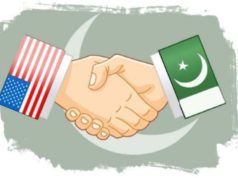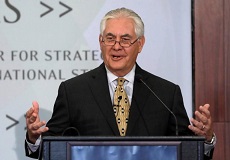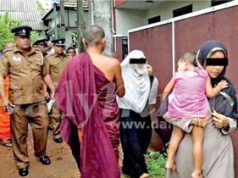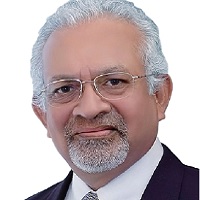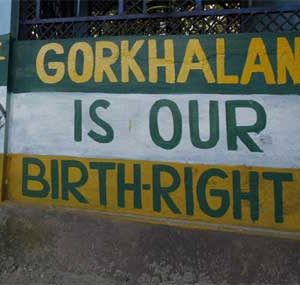Welcome or not, it does look like the Chinese are here to stay, at least in Hambantota, Sri Lanka. In the port and the envisaged industrial zone, to be precise, it’s been about brickbats or bouquets. More accurately, there’s been quite a lot of brickbats these days, especially from the old chum of the Chinese, former Sri Lankan President Mahinda Rajapaksa, whose honeymooning days with China seem to be over.
The former president who was ready to hand over much of Sri Lanka on a virtual golden platter to the Chinese through diverse investment deals, had given his competitor in the presidential race of 8 January 2015, Maithripala Sirisena, the chance to pontificate from election platforms on how he was going to free Sri Lanka from Chinese clutches. But Rajapaksa is now using the same slogan to lash out at Sirisena.
Among the alleged anti-national mechanisms of the government, according to Rajapaksa, the Chinese projects get an important place in the same manner it did when Maithripala Sirisena was keeping count of similar Rajapaksa ‘sins’ on diverse election podiums around the country prior to 8 January 2015.
Apart from the ramifications of the Chinese impact on recent Lankan politics, the current controversy involving China and the Hambantota Port is outwardly visible mainly over the ‘grant’ of 80 percent stake of the port to the Chinese state-owned China Merchant Ports Holding Company, and the provision of 15,000 acres for the China-backed Southern Economic Development Zone. There are a host of other security and strategic interest concerns related to the port handover.
The present regime argues that the only way to develop the Colombo and other harbors in Sri Lanka is by making the public-private partnership in Hambantota a commercial success, changing the current paradigm where Hambantota and other ports are sustained with the profits generated by the Colombo port. Where Chinese negotiations are concerned, the Chinese had reportedly asked the government for a 199 lease, finally settling for 99 years.
The government, nevertheless, is concerned about national strategic interests revolving around the arrangement with the Chinese. They will want to avoid a situation where Sri Lanka will have virtually no control over the port. The fear then is that the Hambantota Port will be Chinese and not Sri Lankan. And lining that fear is the inviting of unwanted international strategic interests concerning the port and converting Sri Lanka into a theater of regional and global rivalries, principally between China and India.
Reportedly, the Sri Lanka Ports Authority had wanted full control of handling the security of the port, while adamant Chinese negotiators insisted on doing this on their own.
The Framework Agreement discussed so far sees the Chinese-led venture gaining authority over port security service, pilotage, key decision making in directing ship movement, navigation service, shipping as well as trans-shipping, warehousing, mooring service, wharfage, supply of water, fuel and electricity, bunkering, to name a few aspects, while the Chinese also gain control of diving and ship repair including underwater ship repair service, handling petroleum and a host of other services connected to all services stated above.
The joint venture, as the Chinese involvement is referred to in the framework set so far, means that the port will be jointly run by the Chinese company and the Sri Lanka Ports Authority (SLPA). However since China will be given 80 percent of the shares of the joint company (as per the current plan), it will have much greater control over the port than the SLPA which will get only 20 percent of the shares. An assessment of the list of tasks assigned to the Chinese show that most of the port’s operations will be under Chinese control.
The Chinese company will thereby acquire or lease, all operational assets and common user facilities, including container terminals, multi-purpose terminals and oil terminals with fuel storage and supply facilities, the manmade island, sea channel, breakwater, access road, turning basin, navigation, cofferdam and common user terminals. The term ‘joint venture’ encompasses representatives of the Sri Lanka Navy, Sri Lanka Police and Sri Lanka Ports Authority, but the reality is the Chinese company will have an upper hand of the control remains, unless the current framework is drastically changed.
Meanwhile, Rajapaksa swears that he never dreamt of any such realities when he contemplated pursuing the port deal with China. In September 2014, under the Mahinda Rajapaksa government, the Sri Lanka Ports Authority (SLPA) had entered into an agreement with the China Merchant Holdings (International) Company Ltd and the China Harbour Engineering Company Ltd, to lease the Hambantota Port (Phase II) on a Supply, Operate and Transfer (SOT) basis for 35 years. With the change in government in 2015, this agreement was nullified on the grounds that the US$ 1.4 billion debt to the Chinese for building the port could not be repaid. China, meanwhile has spent around USD 2 billion, including the cost of building the Mattala Rajapaksa International airport, the iconic albeit mostly empty airport connected directly to the former president’s development plans for his hometown Hambantota which was to incidentally also include an industrial zone, a plush conference center, a cricket stadium of international standards, as well as other development plans such as hotels and housing schemes.
With the Rajapaksa-styled development halted following his shock defeat in the 2015 election and the Sirisena-Wickremesinghe regime unable to dislodge China and handle the debt repayment, both at the same time, it was back to square one concerning negotiations with the Chinese. Thus, the China Harbor Engineering Company Ltd and China Merchant Ports Holding Company Ltd, tendered separate proposals. The criteria for their selection by the Sri Lankan government were however not defined. The China Harbor Engineering Company Ltd proposed an initial payment of approximately US$ 730 million for a 50-year lease period, during which, a payment structure akin to a royalty was proposed, which made the value of this proposal US$ 1.5 billion which was subsequently reported as the option preferred by the Sri Lanka Ports Authority (SLPA).
However, the proposal selected by the current Sirisena-Wickremesinghe regime was that of the China Merchant Ports Holding Company for a one-time payment of US$ 1.08 billion, and a 99 year lease, extendable for a further 99 years, which is the crux of the point of criticism laid against the government by the Rajapaksa faction. The argument of the Sirisena government is that it will immediate get up front payment of USD 1.1 billion which can be used to set off the government’s debts and also that the China Merchants company has experience in running ports which the China Harbor company does not have.
There will be loss of control over the port (100% for 35 years in Rajapaksa’s formula and 80 % for 99 years in Wickremesinghe’s formula). But the worrying aspect, seen from the Lankan lens, is of course the 99 year lease.
The argument holds valid that if the port is leased out for 35 years the Chinese company will try to run the port in a manner so as to earn the most profits as quickly as possible but if the lease is for 99 years, then it will get cocooned in the comfort zone of time and control, possibly using it for other purposes where Sri Lanka will have no say being a minority shareholder.
Another obvious irritant is the grant of 15, 000 acres of land for a Chinese Industrial Zone which Rajapaksa considers to be too much especially as the people in the area are mostly farmers struggling on the fringes of acute poverty and with little hope of betterment of their futures as a result of the Chinese industrial project.
As the situation stands now, Sri Lanka has announced it is going to re-negotiate the deal entered with China. The Minister of Strategic Development and International Trade, Malik Samarawickrama, declared following the public outcry early January by the port workers of Hambantota who were protesting against the China handover, stating that they would lose their jobs in the process, that such a fear was irrational.
The Chinese meanwhile are quite unfazed. As Sri Lankans threw stones and rioted on 7 January 2017 against the controversial Sino-Sri Lankan deal of the Hambantota port, China responded by staunchly declaring commitment to executing its projects in the country and brushed off hostile propaganda by the local opposition parties, stating that ‘no negative force’ can stop China’s development assistance to Sri Lanka as declared by Chinese Ambassador to Sri Lanka, Yi Xianliang at the launch of the China backed Southern Economic Development Zone.
Protesters against the Chinese projects in Sri Lanka, mainly led by loyalists of former Sri Lankan President Mahinda Rajapaksa, were dispersed by police using water cannons as clashes erupted after protesters pelted stones at the area where the project launching ceremony was being held. Meanwhile about 500 non-permanent port workers recruited during Rajapaksa’s rule have been on strike demanding absorption into the regular workforce. They see the current government’s decision of according control of the Port to a Chinese company as a form of ‘privatization’ with fears that once ‘privatized’, the labor force is bound to be pruned drastically by the Chinese.
Chinese Ambassador Yi Xianliang, addressing the launch of the Southern industrial zone in Hambantota on January 07, said, “In 2014, when Chinese President Xi Jinping visited Sri Lanka, we decided to make Sri Lanka our first priority for investments. Then in 2015, President Maithripala Sirisena visited China and we confirmed and decided to support each other. Last April, Prime Minister, Ranil Wickremesinghe visited China and reached a consensus. China will now join Sri Lanka to help it establish its basic industrial system.”
He further said that more than 50 Chinese investors are interested in investing in the Southern Development Project and that at least US$ 5 billion might be invested in the next three to five years, leading to 100,000 jobs to Sri Lankans.
Meanwhile the Sri Lankan government has blamed former President Mahinda Rajapaksa for taking massive loans to build the Hambantota Port, highways and Mattala Airport during his regime, without any realistic repayment plans and the debt-equity swap, seen as an FDI is the only alternative way of getting out of debt.
According to the Lankan Minister of Development Strategies and International Trade, only a Framework Agreement had been signed so far with the Chinese, and eight or nine more agreements are yet to be negotiated. Asked by the media if there is a likelihood of the 80 percent stake being scaled down, Samarwickreme has been evasive but stating that that under no circumstance would Sri Lanka’s stake be less than 20 percent.
Notably, the framework agreement was not signed by the Ports Minister Arjuna Ranatunga but by two other representatives with no connection with ports. But the matter is to be rectified by a new, more representative committee who is re-examining the Framework Agreement. Both Arjuna Ranatunga and Prime Minister Wickremesinghe are of the view that the security of the port should be in the hands of the Sri Lankan Navy. But the question is, how far can the will of the Chinese be bent regarding the control of the Hambantota port?
Meanwhile, there are strong arguments for and against giving an 80 percent stake to the Chinese company, where of course, the strongest case is the conversion of a huge debt into equity, in the current scenario when cash trapped Sri Lanka has a major balance of payments crisis on its hands. And within the realms of reality and political squabbling, China stands firm to ensure that the money it has sunk in Sri Lanka’s port will be recovered and be another global albeit strategic feather in its cap.


